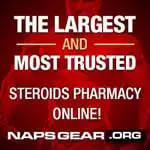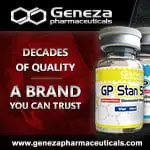You are using an out of date browser. It may not display this or other websites correctly.
You should upgrade or use an alternative browser.
You should upgrade or use an alternative browser.
Letrozole
- Thread starter John Juan
- Start date
Elvia1023
New member
Letrozole versus testosterone. a single-center pilot study of HIV-infected men who have sex with men on highly active anti-retroviral therapy (HAART) with hypoactive sexual desire disorder and raised estradiol levels.
Richardson D1, Goldmeier D, Frize G, Lamba H, De Souza C, Kocsis A, Scullard G.
Author information
Abstract
INTRODUCTION:
Since the advent of Highly Active Anti-Retroviral Therapy (HAART), men with HIV experience good quality of life and expect to have normal sexual function. However, it appears that men infected with HIV commonly complain of sexual problems. There is evidence that men on HAART develop low sexual desire that is associated with raised estradiol levels. It has been postulated that abnormal metabolism seen in this group of men increases the aromatization of testosterone to estradiol. We hypothesized that letrozole, an aromatase inhibitor that inhibits the conversion of testosterone to estradiol, would be beneficial in these men.
AIM:
The aim of this study was to compare the effects of testosterone vs. an aromatase inhibitor, letrazole, in HIV-infected men with raised estradiol and low sexual desire.
METHODS:
Thirteen men who have sex with men on HAART with low sexual desire as well as raised estradiol levels (>120 pmol/L) were randomly allocated to receive either parenteral testosterone (Sustanon 250 intramuscular injection) (N = 6) or letrozole 2.5 mg orally daily (N = 7) for 6 weeks.
MAIN OUTCOME MEASURES:
Sex steroid hormone assays, sex hormone-binding globulin, virological, hematological, and biochemical parameters were measured before and after treatment. Each subject was given the Spector Sexual Desire Inventory and the Depression/Anxiety Stress Scale before and immediately after treatment. Subjects were also asked to estimate the number of actual sexual acts before and after treatment. Results. Inventory data showed a rise in dyadic desire in both treatment arms. Mean actual sexual acts rose from 0.33 to 1.5 in the testosterone group and from 0.43 to 1.29 for the letrozole group. Luteinizing hormone increased in seven of seven men on letrozole. Serum testosterone increased in seven of seven men on letrozole. There were no adverse events from either medication.
CONCLUSION:
Letrozole may be useful in the management of men on HAART who have low sexual desire.
Richardson D1, Goldmeier D, Frize G, Lamba H, De Souza C, Kocsis A, Scullard G.
Author information
Abstract
INTRODUCTION:
Since the advent of Highly Active Anti-Retroviral Therapy (HAART), men with HIV experience good quality of life and expect to have normal sexual function. However, it appears that men infected with HIV commonly complain of sexual problems. There is evidence that men on HAART develop low sexual desire that is associated with raised estradiol levels. It has been postulated that abnormal metabolism seen in this group of men increases the aromatization of testosterone to estradiol. We hypothesized that letrozole, an aromatase inhibitor that inhibits the conversion of testosterone to estradiol, would be beneficial in these men.
AIM:
The aim of this study was to compare the effects of testosterone vs. an aromatase inhibitor, letrazole, in HIV-infected men with raised estradiol and low sexual desire.
METHODS:
Thirteen men who have sex with men on HAART with low sexual desire as well as raised estradiol levels (>120 pmol/L) were randomly allocated to receive either parenteral testosterone (Sustanon 250 intramuscular injection) (N = 6) or letrozole 2.5 mg orally daily (N = 7) for 6 weeks.
MAIN OUTCOME MEASURES:
Sex steroid hormone assays, sex hormone-binding globulin, virological, hematological, and biochemical parameters were measured before and after treatment. Each subject was given the Spector Sexual Desire Inventory and the Depression/Anxiety Stress Scale before and immediately after treatment. Subjects were also asked to estimate the number of actual sexual acts before and after treatment. Results. Inventory data showed a rise in dyadic desire in both treatment arms. Mean actual sexual acts rose from 0.33 to 1.5 in the testosterone group and from 0.43 to 1.29 for the letrozole group. Luteinizing hormone increased in seven of seven men on letrozole. Serum testosterone increased in seven of seven men on letrozole. There were no adverse events from either medication.
CONCLUSION:
Letrozole may be useful in the management of men on HAART who have low sexual desire.
Elvia1023
New member
Elvia, is .33 of a sexual act where you just get one of those tease sessions, a one minute dick sucking and then she goes home. Hahaha it's great how studies reduce sex acts down to a oercent of the act. Hahaha
These were gay men so I suspect it would be a finger up their bottom haha

John Juan
New member
These were gay men so I suspect it would be a finger up their bottom haha
Hahaha maybe a quick tossing of the salad.

John Juan
New member
Short-term aromatase inhibition: effects on glucose metabolism and serum leptin levels in young and elderly men
Abstract
Objective To assess and compare the effects of short-term aromatase inhibition on glucose metabolism, lipid profile, and adipocytokine levels in young and elderly men.
Design and methods Ten elderly and nine young healthy men were randomized to receive letrozole 2.5 mg daily or placebo for 28 days in a crossover design.
Results Both in young and elderly men, active treatment significantly increased serum testosterone (+128 and +99%, respectively) and decreased estradiol levels (−41 and −62%, respectively). Fasting glucose and insulin levels decreased in young men after active intervention (−7 and −37%, respectively) compared with placebo. Leptin levels fell markedly in both age groups (−24 and −25%, respectively), while adiponectin levels were not affected by the intervention. Lipid profile was slightly impaired in both groups, with increasing low density lipoprotein-cholesterol levels (+14%) in the younger age group and 10% lower levels of APOA1 in the elderly. A decline in IGF1 levels (−15%) was observed in the younger age group. No changes in weight or body mass index were observed in either young or old men.
Conclusions Short-term aromatase inhibition appears to affect glucose metabolism in young men, and lipid metabolism, including leptin secretion, in young and elderly men. Furthermore, the short period of exposure suggests that these changes might be mediated by direct effects of sex steroids rather than by changes in body composition.
Abstract
Objective To assess and compare the effects of short-term aromatase inhibition on glucose metabolism, lipid profile, and adipocytokine levels in young and elderly men.
Design and methods Ten elderly and nine young healthy men were randomized to receive letrozole 2.5 mg daily or placebo for 28 days in a crossover design.
Results Both in young and elderly men, active treatment significantly increased serum testosterone (+128 and +99%, respectively) and decreased estradiol levels (−41 and −62%, respectively). Fasting glucose and insulin levels decreased in young men after active intervention (−7 and −37%, respectively) compared with placebo. Leptin levels fell markedly in both age groups (−24 and −25%, respectively), while adiponectin levels were not affected by the intervention. Lipid profile was slightly impaired in both groups, with increasing low density lipoprotein-cholesterol levels (+14%) in the younger age group and 10% lower levels of APOA1 in the elderly. A decline in IGF1 levels (−15%) was observed in the younger age group. No changes in weight or body mass index were observed in either young or old men.
Conclusions Short-term aromatase inhibition appears to affect glucose metabolism in young men, and lipid metabolism, including leptin secretion, in young and elderly men. Furthermore, the short period of exposure suggests that these changes might be mediated by direct effects of sex steroids rather than by changes in body composition.
John Juan
New member
Limits Advanced Journal list Help
Journal ListIndian J Endocrinol Metabv.17(Suppl1); Oct 2013PMC3830326
Indian J Endocrinol Metab. Oct 2013; 17(Suppl1): S259–S261.
doi: 10.4103/2230-8210.119594
PMCID: PMC3830326
Aromatase inhibitors in male sex
Santosh Kumar Singh
Author information ► Copyright and License information ►
Go to:
ABSTRACT
Aromatase inhibitors (AI) have been used in males in idiopathic short stature, constitutional delay of puberty, precocious puberty, gynecomastia, oligospermia, hypogonadism related to obesity and ageing. This retrospective study echoed the benefit of AI in Indian males in varied conditions.
Keywords: Aromatase inhibitors, constitutional delay of puberty, hypogonadism
Go to:
Introduction
Aromatase inhibitors (AI) have been used in the treatment of idiopathic short stature (ISS), constitutional delay of puberty (CDP) and precocious puberty in boys to increase adult height. Moreover, it has been used in the management of gynecomastia, oligospermia and male hypogonadism related to obesity and ageing.[1,2,3] This retrospective study was carried out to assess the efficacy of letrozole, an AI, in varied conditions in Indian males.
Go to:
Case Reports
Case A
A 15-year-old male presented with macromastia. He had delayed puberty.
Wt - 62.7 kg; Ht - 155 cm; Sexual Maturation Rate (SMR) - G1P1, testes - 3 ml, stretched penile length (SPL) - 5 cm.
LH - 6.3 IU/L, follicle-stimulating hormone (FSH) - 2.9 IU/L, prolactin (PRL) - 5.1 ng/ml, normal thyroid-stimulating hormone (TSH) and T4.
Testosterone (T) - 43.8 ng/dl and estradiol (E2) - 9.79 pg/ml. T/E2 = 4.4:1. He was prescribed letrozole 2.5 mg - 3 times/week.
After 6 months of AI therapy:
Wt - 68.8 kg; Ht - 158.5 cm; SMR - G3P3, testes 10 ml, SPL - 6 cm. There was insignificant change in breast enlargement.
T - 331.62 ng/dl; E2-8.05 pg/ml. T/E2 = 41.2.
There was 650% increase in T and 17.9% decrease in E2.
Case B
A 14-year-old male was referred for obesity. He had delayed puberty.
Wt - 66.6 kg; Ht - 158 cm; SMR - G1P1, SPL - 4 cm.
LH - 3.59 IU/L; FSH - 2.48 IU/L; PRL - 13.8 ng/ml, normal TSH and T4.
T - 25.81 ng/dl; E2 - 141.3 pg/ml; T/E2 = 0.18:1.
He was prescribed injection T - 100 mg monthly and letrozole 2.5 mg - 3 times/week for 4 months. After 3 weeks of last dose of injection T and 3 days of last dose of letrozlole: Wt - 68.9 kg; Ht - 159.5 cm; SMR-G2P2, SPL ~5 cm.
T - 310.6 ng/dl; E2 - 13.15 pg/ml; T/E2 = 23.6:1.
There was ~1100% increase in T and 90% decrease in E2.
Case C
A 23-year-old male was referred for management of hypogonadism.
Wt - 55.9 kg; Ht - 161 cm; body mass index - 21.6; no anosmia; SMR - G1P1, SPL - 4 cm. LH <0.07 IU/L, FSH - 0.032 IU/L, PRL - 4.93 ng/ml, T - 13 ng/dl.
He was prescribed injection T - 100 mg every 3 weeks along with letrozole 2.5 mg - 2 times/week. After 3 weeks of last (4th) injection T and 3 days of last letrozole dose: T - 74 ng/dl.
There was 469% increase in T.
Case D
A 27-year-old male was referred for poor semen quality. His total functional sperm fraction (TFSF), denoted by sperm count (×106) by normal morphology (%) by normal motility (%), was 70 × 106/ml × 30% × 30% =6.3.
T - 257.9 ng/dl; E2 - 35.8 pg/ml; T/E2 = 7.2:1.
He was prescribed letrozole - 2.5 mg - 2 times/week.
After 1 month of therapy: T - 754.9 ng/dl; E2 - 28.5 pg/ml; T/E2 = 26.5:1.
There was 200% increase in T and 20% decrease in E2.
TFSF - 80 × 106 × 70% × 30% =16.8.
Go to:
Discussion
AI have been used in boys with ISS and CDP to increase adult height.[1,4,5] Boys with ISS with a mean age of 11 years were treated with letrozole 2.5 mg once daily or placebo for 2 years. There was a gain of 5.9 cm in predicted adult height in the letrozole treated group.[4] A significant increase in predicted adult height has also been observed in boys with CDP who were treated with a combination of T and letrozole.[5] AI slow down epiphyseal maturation by lowering E2 levels. This approach proved successful in other conditions, too, viz. aromatase excess syndrome, sertoli cell tumors and testotoxicosis (along with antiandrogen).[1] AI have limited efficacy in the treatment of gynecomastia; hence, they are not recommended as a first line treatment for gynecomastia.[1] Significant improvement in SMR was observed in CDP cases (Case A and B). There was marked improvement in SMR in case A with “sole” therapy with letrozole, but insignificant response in gynecomastia. Case B was treated with a “combination” of T and letrozole.
AI therapy is associated with a sustained increase in FSH and a positive effect on sperm concentration and motility.[1] Case D (T <300 ng/dl; T/E <10:1) showed improvement in semen quantity and quality with letrozole even though sperm count was normal. Some men with severe oligospermia (<5 × 106/ml), low T levels (<300 ng/dl), T (ng/dl) to E2 (pg/ml) ratio <10 and normal gonadotropins concentration may have a treatable endocrinopathy. AI have been successfully used in this subset of patients.[1,3,6] 2.5 mg/d letrozole for 6 months has been shown to improve seminal parameters (denoted by TFSF).[3]
AI have been used in the treatment of hypogonadism related with obesity and ageing. Letrozole 2.5 mg once a week produced sustained normalization of serum total T in males with obesity related hypogonadism; however, free T rose to supraphysiological levels emphasizing the need for estimation of free T during AI treatment.[2]
It has been suggested that aromatase is less suppressed in the testis compared with adipocytes and muscle tissue. It is questionable whether AI are able to stimulate T production sufficiently in men with truly low T levels.[1] There was a marked increase in T with combination treatment with T and letrozole in CDP (Case B) as compared with Idiopathic Hypogonadotropic Hypogonadism (IHH) (Case C) where there was lesser response with the same combination therapy. The marked increased in T with letrozole in CDP as compared to lesser response in IHH can aid in distinguishing the two conditions with the use of AI.
Most of the recent studies with AI in boys and adult men do not show a major detrimental effects (including bone).[1] The harmful effects are unlikely if the dose is carefully adjusted (even weekly) based on T and E2 levels.[3]
This retrospective study in Indian males showed insignificant effect of AI in gynecomastia and IHH, significant effect in CDP and some benefit in improving seminal parameters. Moreover, this study highlights the importance of estimating E2 (along with T and gonadotropins) in various endocrinopathies, which can be benefitted by reducing E2 by AI.
Further prospective, randomized, blinded, placebo-controlled, long-term studies are needed to clarify the role of AI in the management of growth impairment, male infertility and hypogonadism.
Journal ListIndian J Endocrinol Metabv.17(Suppl1); Oct 2013PMC3830326
Indian J Endocrinol Metab. Oct 2013; 17(Suppl1): S259–S261.
doi: 10.4103/2230-8210.119594
PMCID: PMC3830326
Aromatase inhibitors in male sex
Santosh Kumar Singh
Author information ► Copyright and License information ►
Go to:
ABSTRACT
Aromatase inhibitors (AI) have been used in males in idiopathic short stature, constitutional delay of puberty, precocious puberty, gynecomastia, oligospermia, hypogonadism related to obesity and ageing. This retrospective study echoed the benefit of AI in Indian males in varied conditions.
Keywords: Aromatase inhibitors, constitutional delay of puberty, hypogonadism
Go to:
Introduction
Aromatase inhibitors (AI) have been used in the treatment of idiopathic short stature (ISS), constitutional delay of puberty (CDP) and precocious puberty in boys to increase adult height. Moreover, it has been used in the management of gynecomastia, oligospermia and male hypogonadism related to obesity and ageing.[1,2,3] This retrospective study was carried out to assess the efficacy of letrozole, an AI, in varied conditions in Indian males.
Go to:
Case Reports
Case A
A 15-year-old male presented with macromastia. He had delayed puberty.
Wt - 62.7 kg; Ht - 155 cm; Sexual Maturation Rate (SMR) - G1P1, testes - 3 ml, stretched penile length (SPL) - 5 cm.
LH - 6.3 IU/L, follicle-stimulating hormone (FSH) - 2.9 IU/L, prolactin (PRL) - 5.1 ng/ml, normal thyroid-stimulating hormone (TSH) and T4.
Testosterone (T) - 43.8 ng/dl and estradiol (E2) - 9.79 pg/ml. T/E2 = 4.4:1. He was prescribed letrozole 2.5 mg - 3 times/week.
After 6 months of AI therapy:
Wt - 68.8 kg; Ht - 158.5 cm; SMR - G3P3, testes 10 ml, SPL - 6 cm. There was insignificant change in breast enlargement.
T - 331.62 ng/dl; E2-8.05 pg/ml. T/E2 = 41.2.
There was 650% increase in T and 17.9% decrease in E2.
Case B
A 14-year-old male was referred for obesity. He had delayed puberty.
Wt - 66.6 kg; Ht - 158 cm; SMR - G1P1, SPL - 4 cm.
LH - 3.59 IU/L; FSH - 2.48 IU/L; PRL - 13.8 ng/ml, normal TSH and T4.
T - 25.81 ng/dl; E2 - 141.3 pg/ml; T/E2 = 0.18:1.
He was prescribed injection T - 100 mg monthly and letrozole 2.5 mg - 3 times/week for 4 months. After 3 weeks of last dose of injection T and 3 days of last dose of letrozlole: Wt - 68.9 kg; Ht - 159.5 cm; SMR-G2P2, SPL ~5 cm.
T - 310.6 ng/dl; E2 - 13.15 pg/ml; T/E2 = 23.6:1.
There was ~1100% increase in T and 90% decrease in E2.
Case C
A 23-year-old male was referred for management of hypogonadism.
Wt - 55.9 kg; Ht - 161 cm; body mass index - 21.6; no anosmia; SMR - G1P1, SPL - 4 cm. LH <0.07 IU/L, FSH - 0.032 IU/L, PRL - 4.93 ng/ml, T - 13 ng/dl.
He was prescribed injection T - 100 mg every 3 weeks along with letrozole 2.5 mg - 2 times/week. After 3 weeks of last (4th) injection T and 3 days of last letrozole dose: T - 74 ng/dl.
There was 469% increase in T.
Case D
A 27-year-old male was referred for poor semen quality. His total functional sperm fraction (TFSF), denoted by sperm count (×106) by normal morphology (%) by normal motility (%), was 70 × 106/ml × 30% × 30% =6.3.
T - 257.9 ng/dl; E2 - 35.8 pg/ml; T/E2 = 7.2:1.
He was prescribed letrozole - 2.5 mg - 2 times/week.
After 1 month of therapy: T - 754.9 ng/dl; E2 - 28.5 pg/ml; T/E2 = 26.5:1.
There was 200% increase in T and 20% decrease in E2.
TFSF - 80 × 106 × 70% × 30% =16.8.
Go to:
Discussion
AI have been used in boys with ISS and CDP to increase adult height.[1,4,5] Boys with ISS with a mean age of 11 years were treated with letrozole 2.5 mg once daily or placebo for 2 years. There was a gain of 5.9 cm in predicted adult height in the letrozole treated group.[4] A significant increase in predicted adult height has also been observed in boys with CDP who were treated with a combination of T and letrozole.[5] AI slow down epiphyseal maturation by lowering E2 levels. This approach proved successful in other conditions, too, viz. aromatase excess syndrome, sertoli cell tumors and testotoxicosis (along with antiandrogen).[1] AI have limited efficacy in the treatment of gynecomastia; hence, they are not recommended as a first line treatment for gynecomastia.[1] Significant improvement in SMR was observed in CDP cases (Case A and B). There was marked improvement in SMR in case A with “sole” therapy with letrozole, but insignificant response in gynecomastia. Case B was treated with a “combination” of T and letrozole.
AI therapy is associated with a sustained increase in FSH and a positive effect on sperm concentration and motility.[1] Case D (T <300 ng/dl; T/E <10:1) showed improvement in semen quantity and quality with letrozole even though sperm count was normal. Some men with severe oligospermia (<5 × 106/ml), low T levels (<300 ng/dl), T (ng/dl) to E2 (pg/ml) ratio <10 and normal gonadotropins concentration may have a treatable endocrinopathy. AI have been successfully used in this subset of patients.[1,3,6] 2.5 mg/d letrozole for 6 months has been shown to improve seminal parameters (denoted by TFSF).[3]
AI have been used in the treatment of hypogonadism related with obesity and ageing. Letrozole 2.5 mg once a week produced sustained normalization of serum total T in males with obesity related hypogonadism; however, free T rose to supraphysiological levels emphasizing the need for estimation of free T during AI treatment.[2]
It has been suggested that aromatase is less suppressed in the testis compared with adipocytes and muscle tissue. It is questionable whether AI are able to stimulate T production sufficiently in men with truly low T levels.[1] There was a marked increase in T with combination treatment with T and letrozole in CDP (Case B) as compared with Idiopathic Hypogonadotropic Hypogonadism (IHH) (Case C) where there was lesser response with the same combination therapy. The marked increased in T with letrozole in CDP as compared to lesser response in IHH can aid in distinguishing the two conditions with the use of AI.
Most of the recent studies with AI in boys and adult men do not show a major detrimental effects (including bone).[1] The harmful effects are unlikely if the dose is carefully adjusted (even weekly) based on T and E2 levels.[3]
This retrospective study in Indian males showed insignificant effect of AI in gynecomastia and IHH, significant effect in CDP and some benefit in improving seminal parameters. Moreover, this study highlights the importance of estimating E2 (along with T and gonadotropins) in various endocrinopathies, which can be benefitted by reducing E2 by AI.
Further prospective, randomized, blinded, placebo-controlled, long-term studies are needed to clarify the role of AI in the management of growth impairment, male infertility and hypogonadism.
Elvia1023
New member
A customer at another forum we are on said his gyno went away almost immediately by using our letrozole. He was shocked at how efficient letrozole is.
I have had a lot of guys tell me exactly the same. I just ordered some myself but not for gyno
Similar threads
- Replies
- 5
- Views
- 380
- Replies
- 1
- Views
- 829
- Replies
- 22
- Views
- 3K
- Replies
- 13
- Views
- 3K
- Replies
- 13
- Views
- 3K


 Please Scroll Down to See Forums Below
Please Scroll Down to See Forums Below 










